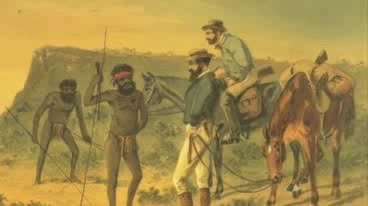Free for educational use
European Observers
Year of production - 2008
Duration - 2min 20sec
Tags - aborigines, colonialism, Indigenous Australia, maps, mythology, terra nullius, The Dreaming, traditions, see all tags
On this Page

How to Download the Video Clip
To download a free copy of this Video Clip choose from the options below. These require the free Quicktime Player.
![]() Premium MP4 europeanobserve_pr.mp4 (17.2MB).
Premium MP4 europeanobserve_pr.mp4 (17.2MB).
![]() Broadband MP4 europeanobserve_bb.mp4 (8.1MB), suitable for iPods and computer downloads.
Broadband MP4 europeanobserve_bb.mp4 (8.1MB), suitable for iPods and computer downloads.
European Observers is a video clip from the documentary series and website First Australians produced in 2008 by Blackfella Films for SBS Television. First Australians chronicles the birth of contemporary Australia as never told before, from the perspective of its first people. First Australians explores what unfolds when the oldest living culture in the world is overrun by the world’s greatest empire.
Students will:
- discuss and reflect upon the significance to Australians today of first contact by European observers with the indigenous population around the Sydney region in the early days of British colonialism, and of the ways in which these events were understood, interpreted and recorded, and re-examined today in the light of contemporary research and thought.
- work collaboratively to plan, construct, write and/or orally present, and explain alternative viewpoints in the interpretation of the content of the video clip.
- draw on and extrapolate from their learning to carry out appropriate wider research and to construct a written, balanced, argumentative report relevant to contemporary Australian society.
January 26, 1788, was a very important day in Australia’s long and ancient history. It was the day on which the British arrived at what is now known as Sydney, New South Wales, with the intention of taking control and possession of the land in the name of the British Government and the King. From that day on, the lives of Australia’s indigenous peoples, their culture, history and traditions, were forever changed, and the effects of this continue to the present day.
The role of the new British colony was essentially to provide a jail for transported convicts in order to relieve the badly overcrowded prison system in England. The British believed Australia’s indigenous population to be lacking in any form of government or religion, and would therefore not have considered their arrival on Australian shores an ‘invasion’. There was no written language, and therefore no written records, no deeds of ownership upon which European society functioned. The land was empty. It was terra nullius.
- From the video clip of European Observers, discuss in class then write responses to the following:
- Describe and explain the ways in which the details of first contact by Europeans with the indigenous peoples of the Sydney district in 1788 has been pieced together by today’s historians.
- Explain what historian Inga Clendinnen means, in the clip, where she says that at the time of first contact in 1788 Aboriginal people probably had the “deepest history known to mankind”.
- Explain the problems to which Professor Marcia Langton refers when we read and view the primary historical records and documents that exist from the time of first European contact with the Sydney nations.
- Examine the sequence of the video clip involving the observations of David Collins. Using this as an example, work in pairs to write descriptions and explanations of a particular activity, such as a ritual dance or enactment, and witnessed for the first time by Europeans. One record should be written or orally narrated from an indigenous viewpoint, while the other should be presented from the European perspective. Provide an account to the class of the differences in interpretation between the two records. The class may also be invited to discuss the reasons for the differences, and to expand upon the content of the two records.
- Do you think new immigrants to Australia today should be compulsorily educated about the history of first contact of immigrant cultures with the indigenous populace of 1788? Carry out appropriate research then plan and write a reasoned report either in favour or against the proposition, for a government committee appointed to oversee the functions and management of immigration programs.
Inga Clendinnen, “The History Question: Who Owns the Past”, Quarterly Essay, Issue 23, Black Ink, Melbourne, 2006
D.J. Mulvaney, Encounters in Place: Outsiders and Aboriginal Australians 1606–1985, University of Queensland Press, St Lucia, Qld, 1989
Rachel Perkins and Marcia Langton (eds), First Australians: An Illustrated History, Melbourne University Publishing, Carlton, Vic, 2008
Watkin Tench, edited and introduced by Tim Flannery, 1788: Compromising a Narrative of the Expedition to Botany Bay and a Complete Account of the Settlement at Port Jackson, Text Publishing, Melbourne, 1996
Go to First Australians
Go to First contact, Sydney
Go to First contact with the Eora of Sydney
Go to British Colonisation


